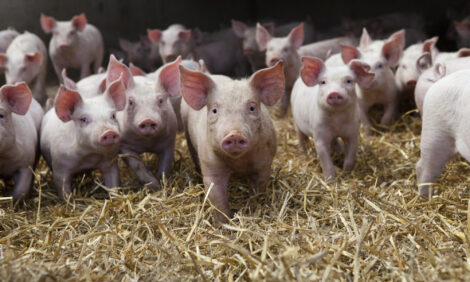



British Pig Market
UK - Mick Sloyan, Chief Executive of the British Pig Executive (BPEX) gave the first presentation at the European Pig Producers (EPP) Congress in the city of Norwich on 5 June 2008, reports Jackie Linden, editor ThePigSite. |
|
Mick Sloyan
|
As an introduction to the local pig industry for the 240 Congress participants from all over Europe, he outlined the organisation of BPEX, production industry, abattoirs and the overall market for pig meat in the UK.
BPEX Organisation
BPEX is a statutory organisation financed by a levy on pig producers and abattoirs. The current levy is £0.75 per pig slaughtered for the producers, and £0.20 per pig slaughtered for abattoirs. Total budget is around £7 million. Its main activities are marketing, research and technical advice. BPEX came under the umbrella of the new Agricultural and Horticulture Development Board from 1 April 2008.
The BPEX Board comprises six producers, three processors, one independent member and three officers, all under Chairman, Stewart Houston.
Production Industry
After many years in decline, the breeding herd has stabilised at around 450,000 sows in the last three years. Factors causing the decline include the need for heavy investment in high-welfare production systems prior to 1999, disruption caused by classical swine fever in 2000 and foot-and-mouth disease in 2001, followed by PRRS, PMWS and PDNS. All of these factors conspired to undermine confidence in the industry. "However, there have been signs of recovery in the last two years - at least, until the feed price crisis," Mr Sloyan commented.
Nationally, average sow production has shown an upward trend over the last five years from around 16.5 pigs per sow per year in 2003 to 21.0 this year. Mr Sloyan predicted a stabilisation this year and a further rise next year, possibly to reach 22.5 pigs per sow per year by the end of 2009.
The regions of the UK most densely populated by pigs are Humberside in north-east England and East Anglia in the east of the country. There are 10,000 pig premises but 1600 farms account for 92 per cent of production. Concentration of the industry has progressed to such an extent that 35 companies account for half of all pigs, and ten companies have 35 per cent of breeding sows. There is a move to two- or three-site organisations and 'all-in, all out' systems.
Since the ban on stalls and tethers, all dry sows are group-housed, and 40 per cent are now kept free-range. Just seven per cent of slaughter pigs are reared outdoors and only 2 per cent are finished outside. Forty per cent of pigs are finished under contract.
Virtually all pigs are sold directly from the producer to the abattoir and all prices are based on backfat measurement rather than lean meat percentage. Average carcass weight is 78kg (cold weight) and backfat averages 11mm. This equates to a lean meat percentage of 61 per cent. A number of pig marketing groups operate in the UK but there are no co-operatives.
UK prices have been generally stable over the last five years and above the EU average but the relative strength of the euro compared to the British pound has all but eliminated the UK's advantage now. Whilst the British pound has weakened compared to the euro over the last year, it has strengthened against the US dollar.
Slaughterhouses
There are 177 abattoirs in the UK registered to slaughter pigs but just 17 account for 85 per cent of the total and two companies (Tulip and Grampian) kill 63 per cent of the pigs.
 |
| UK Pig Population Density (Pig Slaughterhouses Shown as Coloured Circles |
Quality Assurance
Quality assurance covers the whole chain from feed to final product, concentrating particularly on farm, transport, abattoir and product quality. There is an independent audit once a year on farm, and four times yearly by the farm veterinarian. Slaughterhouses are subjected to two audits annually. The whole system operates to EN45011 standards, and it is approved by the European Commission as a Quality Scheme.UK Market
Overall per-capita consumption is stable at around 25kg per person per year, which is well below the EU average. Overall self-sufficiency stands at about 50 per cent. Denmark and the Netherlands are major suppliers of both chilled pork and processed products such as bacon. In recent years, products have also been imported from Germany, France, Belgium, Spain and Poland. Supermarkets have an 80 per cent share of sales, while discounters are not an important outlet.
Costs of Production
Production costs in April 2008 were significantly higher than the average for 2006 - £1.440 and £1.082 per kilo deadweight, respectively. Rising feed costs account for most of this jump. In 2006, UK costs were well above other countries in the EU. However, looked at in terms of euro cents, costs in the UK have risen less dramatically than, say, in Denmark, France and Germany.


Average production costs per kilo deadweight in 2006 and 2007 were £1.082 and £1.226, respectively. Estimates have been made of the future of production costs in the UK. An average for the current year comes in at £1.453. Predicted costs for 2010 vary between an optimistic £1.202 and a pessimistic £1.809, with £1.423 as a neutral estimate.
"The UK pig industry has suffered some of the gravest challenges in succession of any country," Mr Sloyan concluded, "but it can get back on the road to recovery."
June 2008








